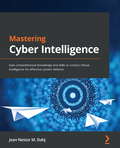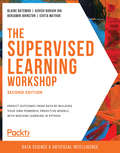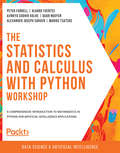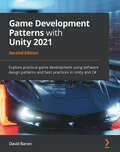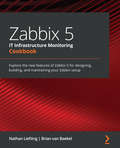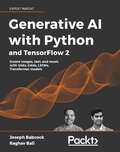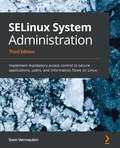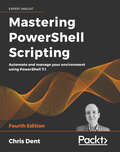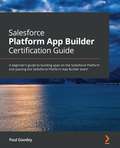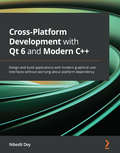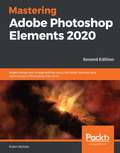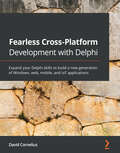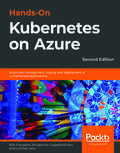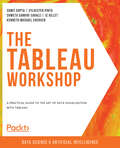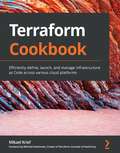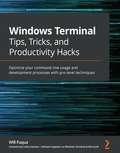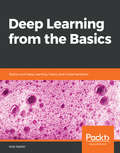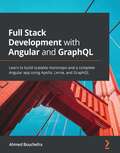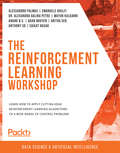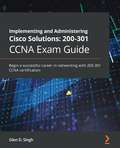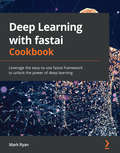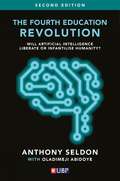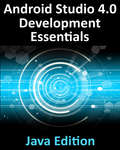- Table View
- List View
Mastering Cyber Intelligence: Gain comprehensive knowledge and skills to conduct threat intelligence for effective system defense
by Jean Nestor DahjDevelop the analytical skills to effectively safeguard your organization by enhancing defense mechanisms, and become a proficient threat intelligence analyst to help strategic teams in making informed decisionsKey FeaturesBuild the analytics skills and practices you need for analyzing, detecting, and preventing cyber threatsLearn how to perform intrusion analysis using the cyber threat intelligence (CTI) processIntegrate threat intelligence into your current security infrastructure for enhanced protectionBook DescriptionThe sophistication of cyber threats, such as ransomware, advanced phishing campaigns, zero-day vulnerability attacks, and advanced persistent threats (APTs), is pushing organizations and individuals to change strategies for reliable system protection. Cyber Threat Intelligence converts threat information into evidence-based intelligence that uncovers adversaries' intents, motives, and capabilities for effective defense against all kinds of threats.This book thoroughly covers the concepts and practices required to develop and drive threat intelligence programs, detailing the tasks involved in each step of the CTI lifecycle. You'll be able to plan a threat intelligence program by understanding and collecting the requirements, setting up the team, and exploring the intelligence frameworks. You'll also learn how and from where to collect intelligence data for your program, considering your organization level. With the help of practical examples, this book will help you get to grips with threat data processing and analysis. And finally, you'll be well-versed with writing tactical, technical, and strategic intelligence reports and sharing them with the community.By the end of this book, you'll have acquired the knowledge and skills required to drive threat intelligence operations from planning to dissemination phases, protect your organization, and help in critical defense decisions.What you will learnUnderstand the CTI lifecycle which makes the foundation of the studyForm a CTI team and position it in the security stackExplore CTI frameworks, platforms, and their use in the programIntegrate CTI in small, medium, and large enterprisesDiscover intelligence data sources and feedsPerform threat modelling and adversary and threat analysisFind out what Indicators of Compromise (IoCs) are and apply the pyramid of pain in threat detectionGet to grips with writing intelligence reports and sharing intelligenceWho this book is forThis book is for security professionals, researchers, and individuals who want to gain profound knowledge of cyber threat intelligence and discover techniques to prevent varying types of cyber threats. Basic knowledge of cybersecurity and network fundamentals is required to get the most out of this book.
The Supervised Learning Workshop: A New, Interactive Approach to Understanding Supervised Learning Algorithms, 2nd Edition
by Benjamin Johnston Ishita Mathur Blaine Bateman Ashish Ranjan JhaCut through the noise and get real results with a step-by-step approach to understanding supervised learning algorithms Key Features Ideal for those getting started with machine learning for the first time A step-by-step machine learning tutorial with exercises and activities that help build key skills Structured to let you progress at your own pace, on your own terms Use your physical print copy to redeem free access to the online interactive edition Book Description You already know you want to understand supervised learning, and a smarter way to do that is to learn by doing. The Supervised Learning Workshop focuses on building up your practical skills so that you can deploy and build solutions that leverage key supervised learning algorithms. You'll learn from real examples that lead to real results. Throughout The Supervised Learning Workshop, you'll take an engaging step-by-step approach to understand supervised learning. You won't have to sit through any unnecessary theory. If you're short on time you can jump into a single exercise each day or spend an entire weekend learning how to predict future values with auto regressors. It's your choice. Learning on your terms, you'll build up and reinforce key skills in a way that feels rewarding. Every physical print copy of The Supervised Learning Workshop unlocks access to the interactive edition. With videos detailing all exercises and activities, you'll always have a guided solution. You can also benchmark yourself against assessments, track progress, and receive content updates. You'll even earn a secure credential that you can share and verify online upon completion. It's a premium learning experience that's included with your printed copy. To redeem, follow the instructions located at the start of your book. Fast-paced and direct, The Supervised Learning Workshop is the ideal companion for those with some Python background who are getting started with machine learning. You'll learn how to apply key algorithms like a data scientist, learning along the way. This process means that you'll find that your new skills stick, embedded as best practice. A solid foundation for the years ahead. What you will learn Get to grips with the fundamental of supervised learning algorithms Discover how to use Python libraries for supervised learning Learn how to load a dataset in pandas for testing Use different types of plots to visually represent the data Distinguish between regression and classification problems Learn how to perform classification using K-NN and decision trees Who this book is for Our goal at Packt is to help you be successful, in whatever it is you choose to do. The Supervised Learning Workshop is ideal for those with a Python background, who are just starting out with machine learning. Pick up a Workshop today, and let Packt help you develop skills that stick with you for life.
The Statistics and Calculus with Python Workshop: A comprehensive introduction to mathematics in Python for artificial intelligence applications
by Peter Farrell Alvaro Fuentes Quan Nguyen Ajinkya Sudhir Kolhe Alexander Joseph Sarver Marios TsatsosWith examples and activities that help you achieve real results, applying calculus and statistical methods relevant to advanced data science has never been so easyKey FeaturesDiscover how most programmers use the main Python libraries when performing statistics with PythonUse descriptive statistics and visualizations to answer business and scientific questionsSolve complicated calculus problems, such as arc length and solids of revolution using derivatives and integralsBook DescriptionAre you looking to start developing artificial intelligence applications? Do you need a refresher on key mathematical concepts? Full of engaging practical exercises, The Statistics and Calculus with Python Workshop will show you how to apply your understanding of advanced mathematics in the context of Python.The book begins by giving you a high-level overview of the libraries you'll use while performing statistics with Python. As you progress, you'll perform various mathematical tasks using the Python programming language, such as solving algebraic functions with Python starting with basic functions, and then working through transformations and solving equations. Later chapters in the book will cover statistics and calculus concepts and how to use them to solve problems and gain useful insights. Finally, you'll study differential equations with an emphasis on numerical methods and learn about algorithms that directly calculate values of functions.By the end of this book, you'll have learned how to apply essential statistics and calculus concepts to develop robust Python applications that solve business challenges.What you will learnGet to grips with the fundamental mathematical functions in PythonPerform calculations on tabular datasets using pandasUnderstand the differences between polynomials, rational functions, exponential functions, and trigonometric functionsUse algebra techniques for solving systems of equationsSolve real-world problems with probabilitySolve optimization problems with derivatives and integralsWho this book is forIf you are a Python programmer who wants to develop intelligent solutions that solve challenging business problems, then this book is for you. To better grasp the concepts explained in this book, you must have a thorough understanding of advanced mathematical concepts, such as Markov chains, Euler's formula, and Runge-Kutta methods as the book only explains how these techniques and concepts can be implemented in Python.
Game Development Patterns with Unity 2021: Explore practical game development using software design patterns and best practices in Unity and C#, 2nd Edition
by David BaronDiscover practical design propositions to resolve game programming challenges in UnityKey FeaturesGet an overview of Unity engine architecture and coding modelBuild a complete racing game using software design patterns and understand how to implement them in UnityDownload the source code of the complete prototype demonstrating each of the software patterns usedBook DescriptionUnity's coding model and architecture require knowledge of common software design patterns. To optimally code a game in Unity, in the same way you do in other engines, you'll have to adapt to programming techniques that involve the use of design patterns. In this second edition, you'll get to grips with using design patterns with the help of supplemented code examples based on actual implementations of game mechanics and systems of a playable racing game prototype. You'll be introduced to the core principles of reusable software patterns and how to employ them to build components efficiently. Some notable additions include a game design document (GDD), a Unity programming primer, and the downloadable source code of a complete prototype. You'll start by learning about the overall design of the core game mechanics and systems that you'll be building throughout this Unity book, and discover tried-and-tested software patterns to code essential components of a game in a structured manner. You'll also find out how you can use classic design patterns to utilize Unity's unique API features. Finally, you'll identify the negative impacts of bad architectural decisions and understand how to overcome them with simple but effective practices. By the end of this book, you'll be able to develop Unity games in a structured, scalable, and optimized way.What you will learnStructure professional Unity code using industry-standard development patternsIdentify the right patterns for implementing specific game mechanics or featuresDevelop configurable core game mechanics and ingredients that can be modified without writing a single line of codeReview practical object-oriented programming (OOP) techniques and learn how they're used in the context of a Unity projectBuild unique game development systems such as a level editorExplore ways to adapt traditional design patterns for use with the Unity APIWho this book is forThis book is for Unity game developers who want to learn industry standards for building Unity games. Knowledge of the Unity game engine and programming in the C# language is expected. If you're only just starting your journey to becoming a Unity game developer, this book is not suitable for you.
Game Development Patterns with Unity 2021: Explore practical game development using software design patterns and best practices in Unity and C#
by David BaronSolve your programming woes in Unity with practical design propositionsKey FeaturesGain a comprehensive overview of Unity engine architecture and coding modelBuild a complete racing game using software design patterns and understand how to implement them in UnityDownload the source code of the complete prototype demonstrating each of the software patterns usedBook DescriptionThis book is written for every game developer ready to tackle the bigger picture and start working with advanced programming techniques and design patterns in Unity. Game Development Patterns with Unity 2021 is an introduction to the core principles of reusable software patterns and how to employ them to build components efficiently. In this second edition, you'll tackle design patterns with the help of a practical example; a playable racing game prototype where you’ll get to apply all your newfound knowledge. Notable updates also include a game design document (GDD), a Unity programming primer, and the downloadable source code of a complete prototype. Your journey will start by learning about overall design of the core game mechanics and systems. You’ll discover tried-and-tested software patterns to code essential components of a game in a structured manner, and start using classic design patterns to utilize Unity's unique API features. As you progress, you'll also identify the negative impacts of bad architectural decisions and understand how to overcome them with simple but effective practices. By the end of this Unity book, the way you develop Unity games will change – you’ll adapt a more structured, scalable, and optimized process that will help you take the next step in your career. What you will learnStructure professional Unity code using industry-standard development patternsIdentify the right patterns for implementing specific game mechanics or featuresDevelop configurable core game mechanics and ingredients that can be modified without writing a single line of codeReview practical object-oriented programming (OOP) techniques and learn how they re used in the context of a Unity projectBuild unique game development systems such as a level editorExplore ways to adapt traditional design patterns for use with the Unity APIWho this book is forThis book is for Unity game developers who want to learn industry standards for building Unity games. Knowledge of the Unity game engine and programming in the C# language is a must, so if you’re a beginner, try our Learning C# by Developing Games with Unity 2021 handbook instead.
Zabbix 5 IT Infrastructure Monitoring Cookbook: Explore the new features of Zabbix 5 for designing, building, and maintaining your Zabbix setup
by Nathan Liefting Brian van BaekelDiscover practical recipes to help you efficiently monitor enterprise IT infrastructure for Windows, Linux, and networkingKey FeaturesFind out how you can leverage some of the most exciting features of Zabbix 5Perform professional IT infrastructure and application monitoring on multiple platformsDiscover easy-to-follow, practical solutions to problems in network monitoring with ZabbixBook DescriptionZabbix offers useful insights into your infrastructure performance and issues and enables you to enhance your monitoring setup with its variety of powerful features. This book covers hands-on, easy-to-follow recipes for using Zabbix 5 for effectively monitoring the performance of devices and applications over networks. The book starts by guiding you through the installation of Zabbix and using the Zabbix frontend. You'll then work your way through the most prominent features of Zabbix and make the right design choices for building a scalable and easily manageable environment. The book contains recipes for building items and triggers for different types of monitoring, building templates, and using Zabbix proxies. As you advance, you'll learn how to use the Zabbix API for customization and manage your Zabbix server and database efficiently. Finally, you'll find quick solutions to the common and not-so-common problems that you may encounter in your everyday Zabbix monitoring work. By the end of this Zabbix book, you'll have learned how to use Zabbix for all your monitoring needs and be able to build a solid Zabbix setup by leveraging its key functionalities.What you will learnExplore the different types of monitoring available in Zabbix 5Find out how to build your own Zabbix templatesUse Zabbix proxies for effective load balancing/scalingWork with custom integrations and the Zabbix APISet up triggers and alerting with Zabbix 5Maintain your Zabbix setup for scaling, backups, and upgradesDiscover how to perform advanced Zabbix database managementMonitor cloud-based products such as Amazon Web Services (AWS), Azure, and DockerWho this book is forThis book is for IT engineers who want to get started with Zabbix and anyone with an intermediate understanding of Zabbix looking to extend their knowledge. Although not necessary, prior experience with Zabbix will help you to make the most of this book.
Generative AI with Python and TensorFlow 2: Create images, text, and music with VAEs, GANs, LSTMs, Transformer models
by Joseph Babcock Raghav BaliFun and exciting projects to learn what artificial minds can createKey FeaturesCode examples are in TensorFlow 2, which make it easy for PyTorch users to follow alongLook inside the most famous deep generative models, from GPT to MuseGANLearn to build and adapt your own models in TensorFlow 2.xExplore exciting, cutting-edge use cases for deep generative AIBook DescriptionMachines are excelling at creative human skills such as painting, writing, and composing music. Could you be more creative than generative AI?In this book, you'll explore the evolution of generative models, from restricted Boltzmann machines and deep belief networks to VAEs and GANs. You'll learn how to implement models yourself in TensorFlow and get to grips with the latest research on deep neural networks.There's been an explosion in potential use cases for generative models. You'll look at Open AI's news generator, deepfakes, and training deep learning agents to navigate a simulated environment. Recreate the code that's under the hood and uncover surprising links between text, image, and music generation.What you will learnExport the code from GitHub into Google Colab to see how everything works for yourselfCompose music using LSTM models, simple GANs, and MuseGANCreate deepfakes using facial landmarks, autoencoders, and pix2pix GANLearn how attention and transformers have changed NLPBuild several text generation pipelines based on LSTMs, BERT, and GPT-2Implement paired and unpaired style transfer with networks like StyleGANDiscover emerging applications of generative AI like folding proteins and creating videos from imagesWho this book is forThis is a book for Python programmers who are keen to create and have some fun using generative models. To make the most out of this book, you should have a basic familiarity with math and statistics for machine learning.
SELinux System Administration: Implement mandatory access control to secure applications, users, and information flows on Linux, 3rd Edition
by Sven VermeulenEnhance Linux security, application platforms, and virtualization solutions with SELinux to work within your boundaries, your rules, and your policiesKey FeaturesLearn what SELinux is, and how it acts as a mandatory access control system on LinuxApply and tune SELinux enforcement to users, applications, platforms, and virtualization solutionsUse real-life examples and custom policies to strengthen the security posture of your systemsBook DescriptionLinux is a dominant player in many organizations and in the cloud. Securing the Linux environment is extremely important for any organization, and Security-Enhanced Linux (SELinux) acts as an additional layer to Linux system security.SELinux System Administration covers basic SELinux concepts and shows you how to enhance Linux system protection measures. You will get to grips with SELinux and understand how it is integrated. As you progress, you'll get hands-on experience of tuning and configuring SELinux and integrating it into day-to-day administration tasks such as user management, network management, and application maintenance. Platforms such as Kubernetes, system services like systemd, and virtualization solutions like libvirt and Xen, all of which offer SELinux-specific controls, will be explained effectively so that you understand how to apply and configure SELinux within these applications. If applications do not exert the expected behavior, you'll learn how to fine-tune policies to securely host these applications. In case no policies exist, the book will guide you through developing custom policies on your own.By the end of this Linux book, you'll be able to harden any Linux system using SELinux to suit your needs and fine-tune existing policies and develop custom ones to protect any app and service running on your Linux systems.What you will learnUnderstand what SELinux is and how it is integrated into LinuxTune Linux security using policies and their configurable settingsManage Linux users with least-privilege roles and access controlsUse SELinux controls in system services and virtualization solutionsAnalyze SELinux behavior through log events and policy analysis toolsProtect systems against unexpected and malicious behaviorEnhance existing policies or develop custom onesWho this book is forThis Linux sysadmin book is for Linux administrators who want to control the secure state of their systems using SELinux, and for security professionals who have experience in maintaining a Linux system and want to know about SELinux. Experience in maintaining Linux systems, covering user management, software installation and maintenance, Linux security controls, and network configuration is required to get the most out of this book.
Mastering PowerShell Scripting: Automate and manage your environment using PowerShell 7.1, 4th Edition
by Chris DentGrasp advanced PowerShell 7.1 functionalities for effective automation of your environmentKey FeaturesSee PowerShell in action, from learning the fundamentals to creating classes, scripts, and modulesWork with dual code for PowerShell 7 and Windows PowerShellAutomate complex tasks, manipulate data, and secure your environmentBook DescriptionPowerShell scripts offer a convenient way to automate various tasks. This comprehensive guide starts with the basics before moving on to advanced topics to help you become a PowerShell 7.1 expert. This extensively revised edition includes two new chapters on debugging and troubleshooting and creating GUIs. Learn the new features of PowerShell 7.1 by working with parameters, objects, and .NET classes from within PowerShell 7.1. As you work through the chapters, you'll see how to efficiently manage substantial amounts of data and interact with other services using PowerShell 7.1. Make the most of PowerShell's automation features, using different methods to parse data, manipulate regular expressions, and work with Windows Management Instrumentation (WMI). Advanced topics include asynchronous processing, desired state configuration, using more complex scripts and filters, debugging issues, and error-handling techniques. By the end of this PowerShell book, you will be an expert in scripting with PowerShell 7.1.What you will learnOptimize code with functions, switches, and looping structuresWork with objects and operators to test and manipulate dataParse and manipulate different data typesCreate scripts and functions using PowerShellUse jobs, runspaces, and runspace pools to run code asynchronouslyWrite .NET classes with ease within PowerShellCreate and implement regular expressions in PowerShell scriptsMake use of advanced techniques to define and restrict the behavior of parametersWho this book is forThis book is aimed at beginners who want to understand the basics as well as experienced system administrators looking to extend their knowledge.Prior knowledge of PowerShell is beneficial but not essential to get the most value from this book. Some familiarity with operating systems would be useful, but not essential.
Mastering PowerShell Scripting: Automate and manage your environment using PowerShell 7.1
by Chris DentThis complete guide takes you on a tour of PowerShell from the basics to its advanced functionality, helping you automate your tedious and time-consuming system admin tasksKey FeaturesAutomate complex tasks, manipulate data, and secure your environmentWork with dual code for PowerShell 7 and Windows PowerShell to maintain compatibility with older versionsSee PowerShell in action, from learning the fundamentals to creating classes, scripts, and modulesBook DescriptionPowerShell scripts offer a convenient way to automate various tasks, but working with them can be daunting. Mastering PowerShell Scripting takes away the fear and helps you navigate through PowerShell's capabilities.This extensively revised edition includes new chapters on debugging and troubleshooting and creating GUIs (online chapter). Learn the new features of PowerShell 7.1 by working with parameters, objects, and .NET classes from within PowerShell 7.1. This comprehensive guide starts with the basics before moving on to advanced topics, including asynchronous processing, desired state configuration, using more complex scripts and filters, debugging issues, and error-handling techniques. Explore how to efficiently manage substantial amounts of data and interact with other services using PowerShell 7.1. This book will help you to make the most of PowerShell's automation features, using different methods to parse data, manipulate regular expressions, and work with Windows Management Instrumentation (WMI).What you will learnOptimize code with functions, switches, and looping structuresTest and debug your scripts as well as raising and catching errorsWork with objects and operators to test and manipulate dataParse and manipulate different data typesUse jobs, runspaces, and runspace pools to run code asynchronouslyWrite .NET classes with ease within PowerShellCreate and implement regular expressions in PowerShell scriptsMake use of advanced techniques to define and restrict the behavior of parametersWho this book is forThis book is for system administrators who want to automate and speed up their processes using PowerShell and Windows PowerShell. You’ll need to know the basics of operating systems, but beginners with no prior experience with PowerShell will have no trouble following along.
Salesforce Platform App Builder Certification Guide
by Paul GoodeyThis Salesforce book is for aspiring developers who want to learn how to build apps on the Salesforce Platform or pass the Salesforce Platform App Builder certification exam. Salesforce administrators who are looking to learn Salesforce development skills to build apps will also find this book useful.
Cross-Platform Development with Qt 6 and Modern C++: Design and build applications with modern graphical user interfaces without worrying about platform dependency
by Nibedit DeyEnhance your cross-platform programming abilities with the powerful features and capabilities of Qt 6Key FeaturesLeverage Qt and C++ capabilities to create modern, cross-platform applications that can run on a wide variety of software applicationsExplore what's new in Qt 6 and understand core concepts in depthBuild professional customized GUI applications with the help of Qt CreatorBook DescriptionQt is a cross-platform application development framework widely used for developing applications that can run on a wide range of hardware platforms with little to no change in the underlying codebase. If you have basic knowledge of C++ and want to build desktop or mobile applications with a modern graphical user interface (GUI), Qt is the right choice for you. Cross-Platform Development with Qt 6 and Modern C++ helps you understand why Qt is one of the favorite GUI frameworks adopted by industries worldwide, covering the essentials of programming GUI apps across a multitude of platforms using the standard C++17 and Qt 6 features.Starting with the fundamentals of the Qt framework, including the features offered by Qt Creator, this practical guide will show you how to create classic user interfaces using Qt Widgets and touch-friendly user interfaces using Qt Quick. As you advance, you'll explore the Qt Creator IDE for developing applications for multiple desktops as well as for embedded and mobile platforms. You will also learn advanced concepts about signals and slots. Finally, the book takes you through debugging and testing your app with Qt Creator IDE.By the end of this book, you'll be able to build cross-platform applications with a modern GUI along with the speed and power of native apps.What you will learnWrite cross-platform code using the Qt framework to create interactive applicationsBuild a desktop application using Qt WidgetsCreate a touch-friendly user interface with Qt QuickDevelop a mobile application using Qt and deploy it on different platformsGet to grips with Model/View programming with Qt Widgets and Qt QuickDiscover Qt's graphics framework and add animations to your user interfaceWrite test cases using the Qt Test framework and debug codeBuild a translation-aware applicationFollow best practices in Qt to write high-performance codeWho this book is forThis book is for application developers who want to use C++ and Qt to create modern, responsive applications that can be deployed to multiple operating systems such as Microsoft Windows, Apple macOS, and Linux desktop platforms. Although no prior knowledge of Qt is expected, beginner-level knowledge of the C++ programming language and object-oriented programming system (OOPs) concepts will be helpful.
Mastering Adobe Photoshop Elements 2020: Supercharge your image editing using the latest features and techniques in Photoshop Elements, 2nd Edition
by Robin NicholsAn example-driven guide to take your image editing skills from beginner to advanced using powerful Photoshop Elements tools and techniques in tandem with Adobe's latest AI technology Key Features Updated to the latest version of Photoshop Elements 2020 with focused coverage on Adobe's latest AI technology Organize, search, and keep track of an ever-increasing number of images and videos using expert practices Discover common solutions to a wide range of photographic and image-editing problems Book Description Adobe Photoshop Elements is a raster graphics editor for entry-level photographers, image editors, and hobbyists. Updated and improved to cover the latest features of Photoshop Elements 2020, this second edition includes focused coverage of Adobe's new AI-powered features that are designed to make the editing process more efficient, creative and fun. This book takes you through the complexities of image editing in easy-to-follow, bite-sized chunks, helping you to quickly recognize the editing challenge at hand and use suitable tools and techniques to overcome it. You'll start by learning how to import, organize, manage, edit, and use your pictures in a format that's designed for creative photography projects. Throughout this Adobe Photoshop Elements book, you'll discover how to fix different photographic problems using an extensive repertoire of commonly applied solutions. Common processes such as applying artistic effects to creative projects, custom image makeovers, processing images for social media, and other file export methods will also be covered. By the end of this book, you'll have learned about the impressive tools available in Photoshop Elements 2020, and how it is designed not only for photographers who'd like to dip their toes into the editing world, but also for those wanting simple but effective ideas on how to expand their creativity while remaining time-efficient. What you will learn Explore the automatic AI-powered features designed to make the editing process faster and more efficient Add graphic elements to any composition, photograph, or illustration Overcome challenges in editing multi-layered images for your photography projects Develop illustrative skills using Photoshop Elements' drawing tools Learn techniques for professional photo retouching Work with online and local templates to create calendars, greeting cards, and other projects Who this book is for This book is for creative and enthusiastic photographers with elementary experience in photo editing. If you are looking to organize your picture collection and take control of post-processing requirements, you'll find this book useful. Though not necessary, photography skills alongside basic photo editing knowledge will help you to get the most out of this book.
Fearless Cross-Platform Development with Delphi: Expand your Delphi skills to build a new generation of Windows, web, mobile, and IoT applications
by David CorneliusLearn to rapidly build and deploy cross-platform applications from a single codebase with practical, real-world solutions using the mature Delphi 10.4 programming environmentKey FeaturesImplement Delphi's modern features to build professional-grade Windows, web, mobile, and IoT applications and powerful serversBecome a Delphi code and project guru by learning best practices and techniques for cross-platform developmentDeploy your complete end-to-end application suite anywhereBook DescriptionDelphi is a strongly typed, event-driven programming language with a rich ecosystem of frameworks and support tools. It comes with an extensive set of web and database libraries for rapid application development on desktop, mobile, and internet-enabled devices. This book will help you keep up with the latest IDE features and provide a sound foundation of project management and recent language enhancements to take your productivity to the next level.You'll discover how simple it is to support popular mobile device features such as sensors, cameras, and GPS. The book will help you feel comfortable working with FireMonkey and styles and incorporating 3D user interfaces in new ways. As you advance, you'll be able to build cross-platform solutions that not only look native but also take advantage of a wide array of device capabilities. You'll also learn how to use embedded databases, such as SQLite and InterBase ToGo, synchronizing them with your own custom backend servers or modules using the powerful RAD Server engine. The book concludes by sharing tips for testing and deploying your end-to-end application suite for a smooth user experience.By the end of this book, you'll be able to deliver modern enterprise applications using Delphi confidently.What you will learnDiscover the latest enhancements in the Delphi IDEOvercome the barriers that hold you back from embracing cross-platform developmentBecome fluent with FireMonkey controls, styles, LiveBindings, and 3D objectsBuild Delphi packages to extend RAD Server or modularize your applicationsUse FireDAC to get quick and direct access to any dataLeverage IoT technologies such as Bluetooth and Beacons and learn how to put your app on a Raspberry PiEnable remote apps with backend servers on Windows and Linux through REST APIsDevelop modules for IIS and Apache web serversWho this book is forThis book is for Delphi developers interested in expanding their skillset beyond Windows programming by creating professional-grade applications on multiple platforms, including Windows, Mac, iOS, Android, and back-office servers. You'll also find this book useful if you're a developer looking to upgrade your knowledge of Delphi to keep up with the latest changes and enhancements in this powerful toolset. Some Delphi programming experience is necessary to make the most out of this book.
Hands-On Kubernetes on Azure: Automate management, scaling, and deployment of containerized applications, 2nd Edition
by Gunther Lenz Shivakumar Gopalakrishnan Nills FranssensKick-start your DevOps career by learning how to effectively deploy Kubernetes on Azure in an easy, comprehensive, and fun way with hands-on coding tasks Key Features Understand the fundamentals of Docker and Kubernetes Learn to implement microservices architecture using the Kubernetes platform Discover how you can scale your application workloads in Azure Kubernetes Service (AKS) Book Description From managing versioning efficiently to improving security and portability, technologies such as Kubernetes and Docker have greatly helped cloud deployments and application development. Starting with an introduction to Docker, Kubernetes, and Azure Kubernetes Service (AKS), this book will guide you through deploying an AKS cluster in different ways. You'll then explore the Azure portal by deploying a sample guestbook application on AKS and installing complex Kubernetes apps using Helm. With the help of real-world examples, you'll also get to grips with scaling your application and cluster. As you advance, you'll understand how to overcome common challenges in AKS and secure your application with HTTPS and Azure AD (Active Directory). Finally, you'll explore serverless functions such as HTTP triggered Azure functions and queue triggered functions. By the end of this Kubernetes book, you'll be well-versed with the fundamentals of Azure Kubernetes Service and be able to deploy containerized workloads on Microsoft Azure with minimal management overhead. What you will learn Plan, configure, and run containerized applications in production Use Docker to build apps in containers and deploy them on Kubernetes Improve the configuration and deployment of apps on the Azure Cloud Store your container images securely with Azure Container Registry Install complex Kubernetes applications using Helm Integrate Kubernetes with multiple Azure PaaS services, such as databases, Event Hubs and Functions. Who this book is for This book is for aspiring DevOps professionals, system administrators, developers, and site reliability engineers looking to understand test and deployment processes and improve their efficiency. If you're new to working with containers and orchestration, you'll find this book useful.
The Tableau Workshop: A practical guide to the art of data visualization with Tableau
by Sumit Gupta Shweta Sankhe-Savale JC Gillet Sylvester Pinto Kenneth Michael ChervenLearn how to bring your data to life with this hands-on guide to visual analytics with TableauKey FeaturesMaster the fundamentals of Tableau Desktop and Tableau PrepLearn how to explore, analyze, and present data to provide business insightsBuild your experience and confidence with hands-on exercises and activitiesBook DescriptionLearning Tableau has never been easier, thanks to this practical introduction to storytelling with data. The Tableau Workshop breaks down the analytical process into five steps: data preparation, data exploration, data analysis, interactivity, and distribution of dashboards. Each stage is addressed with a clear walkthrough of the key tools and techniques you'll need, as well as engaging real-world examples, meaningful data, and practical exercises to give you valuable hands-on experience.As you work through the book, you'll learn Tableau step by step, studying how to clean, shape, and combine data, as well as how to choose the most suitable charts for any given scenario. You'll load data from various sources and formats, perform data engineering to create new data that delivers deeper insights, and create interactive dashboards that engage end-users.All concepts are introduced with clear, simple explanations and demonstrated through realistic example scenarios. You'll simulate real-world data science projects with use cases such as traffic violations, urban populations, coffee store sales, and air travel delays.By the end of this Tableau book, you'll have the skills and knowledge to confidently present analytical results and make data-driven decisions.What you will learnBecome an effective user of Tableau Prep and Tableau DesktopLoad, combine, and process data for analysis and visualizationUnderstand different types of charts and when to use themPerform calculations to engineer new data and unlock hidden insightsAdd interactivity to your visualizations to make them more engagingCreate holistic dashboards that are detailed and user-friendlyWho this book is forThis book is for anyone who wants to get started on visual analytics with Tableau. If you're new to Tableau, this Workshop will get you up and running. If you already have some experience in Tableau, this book will help fill in any gaps, consolidate your understanding, and give you extra practice of key tools.
Terraform Cookbook: Efficiently define, launch, and manage Infrastructure as Code across various cloud platforms
by Mikael KriefThis book is for developers, operators, and DevOps engineers looking to improve their workflow and use Infrastructure as Code. Experience with Microsoft Azure, Jenkins, shell scripting, and DevOps practices is required to get the most out of this Terraform book.
Windows Terminal Tips, Tricks, and Productivity Hacks: Optimize your command-line usage and development processes with pro-level techniques
by Will Fuqua Carlos ZamoraBecome an efficient command-line expert by harnessing the power of the new Microsoft Windows Terminal, and learn time-saving tricks for PowerShell, WSL2, and moreKey FeaturesCustomize and optimize your Windows Terminal and its shellsWork effectively on the command line with split panes, hotkeys, and automationUse PowerShell and WSL2 efficiently to build, test, and deploy applicationsBook DescriptionWindows Terminal is a new and open-source command-line application for Windows 10, built for the Command Prompt, PowerShell, Windows Subsystem for Linux, and more. It's fast, modern, and configurable thanks to its GPU-accelerated rendering, excellent UTF-8 support, and JSON-based configurability, and this book can help you learn how to leverage these features. You'll start by learning the benefits of Windows Terminal and its open-source development, as well as how to use the built-in tabs, panes, and key bindings to build your own efficient terminal workflows. After you've mastered Windows Terminal, this book shows how to use and configure PowerShell Core and the Windows Subsystem for Linux within Windows Terminal. You'll maximize your productivity using powerful tools such as PSReadLine for PowerShell and ZSH on Linux, and discover useful tips and tricks for common developer tools like Git and SSH. Finally, you'll see how Windows Terminal can be used in common development and DevOps tasks, such as developing frontend JavaScript applications and backend REST APIs, and managing cloud-based systems like Amazon Web Services (AWS), Microsoft Azure, and Google Cloud. By the end of this book, you'll not only be well-versed with Windows Terminal, but also have learned how to effectively use shells like PowerShell Core and ZSH to become proficient at the command line.What you will learnInstall, update, and use Windows Terminal and its preview versionCustomize your Windows Terminal to be both visually appealing and functionalEnable and effectively use the latest versions of PowerShell Core and Windows Subsystem for LinuxInstall and configure time-saving tools for the command lineWork efficiently with common developer tools such as Git and SSHBuild, deploy, and manage apps in the cloud using Windows TerminalUse Linux tools from Windows with easeWho this book is forThis book is for developers, DevOps engineers, and sysadmins who want to become advanced command-line power users. Whether you're new to the command line or you already use Windows PowerShell every day, this book will have something for you.
Deep Learning from the Basics: Python and Deep Learning: Theory and Implementation
by Koki SaitohDiscover ways to implement various deep learning algorithms by leveraging Python and other technologiesKey FeaturesLearn deep learning models through several activitiesBegin with simple machine learning problems, and finish by building a complex system of your ownTeach your machines to see by mastering the technologies required for image recognitionBook DescriptionDeep learning is rapidly becoming the most preferred way of solving data problems. This is thanks, in part, to its huge variety of mathematical algorithms and their ability to find patterns that are otherwise invisible to us. Deep Learning from the Basics begins with a fast-paced introduction to deep learning with Python, its definition, characteristics, and applications. You'll learn how to use the Python interpreter and the script files in your applications, and utilize NumPy and Matplotlib in your deep learning models. As you progress through the book, you'll discover backpropagation—an efficient way to calculate the gradients of weight parameters—and study multilayer perceptrons and their limitations, before, finally, implementing a three-layer neural network and calculating multidimensional arrays. By the end of the book, you'll have the knowledge to apply the relevant technologies in deep learning.What you will learnUse Python with minimum external sources to implement deep learning programsStudy the various deep learning and neural network theoriesLearn how to determine learning coefficients and the initial values of weightsImplement trends such as Batch Normalization, Dropout, and AdamExplore applications like automatic driving, image generation, and reinforcement learningWho this book is forDeep Learning from the Basics is designed for data scientists, data analysts, and developers who want to use deep learning techniques to develop efficient solutions. This book is ideal for those who want a deeper understanding as well as an overview of the technologies. Some working knowledge of Python is a must. Knowledge of NumPy and pandas will be beneficial, but not essential.
Full Stack Development with Angular and GraphQL: Learn to build scalable monorepo and a complete Angular app using Apollo, Lerna, and GraphQL
by Ahmed BouchefraUse tools such as Lerna and GraphQL Code Generator to leverage recent features like NPM Workspaces for configuring a mono-repo project and Apollo Client's reactive variables to easily manage the local state of your appKey FeaturesUse Angular modules and components to build apps that you can easily scale and maintain in the futureDevelop a GraphQL API for a small social network app using Node.js, Express, and Apollo ServerUse Apollo Client to integrate Angular with a GraphQL server and manage your application's local stateBook DescriptionAngular is one of the most popular JavaScript frameworks in modern web app development allowing developers to not only build apps and reuse the code but also develop apps for any deployment target. For web, mobile web, native mobile, and native desktop, GraphQL is the modern and REST alternative for querying web APIs. Using Angular, TypeScript and GraphQL will give you a future-proof and scalable stack you can start building apps around. This book shows you how to build apps using cutting-edge technologies. You'll learn how to solve common web development problems with GraphQL and Apollo, such as database access, authentication, and image uploads. The book starts by introducing you to building full stack apps with Angular and GraphQL. Next, you'll learn how to create a monorepo project with Lerna and NPM Workspaces and configure a Node.js app to use GraphQL with Express and Apollo Server. You'll also understand the basics of Angular architecture and routing. Later, the book demonstrates how to build a professionally-looking UI with Angular Material, use Apollo Client to interface with the server to get data from the built GraphQL API. You'll learn about Apollo Client's type and field policies, and various fetching policies. In addition to this, you'll learn about local state management and reactive variables with Apollo Client and how to generate TypeScript types and even Angular Apollo services for your GraphQL schema and queries using GraphQL Code Generator to implement a scalable codebase. By the end of this book, you'll have the skills you need to be able to build your own full stack application.What you will learnCreate a monorepo project with Lerna and NPM workspacesAdd realtime support with GraphQL subscriptionsBuild a frontend with a modular architecture and Material Design UI components to consume the GraphQL APIUse GraphQL Code Generator to generate types and code for a type-safe and scalable code baseCreate Angular modules and smart and dumb components and share data between themUse Apollo Client features such as client-side queries and reactive variables for local state managementWho this book is forThis Angular GraphQL book is for Angular developers who want to learn how to use GraphQL and Apollo with Angular to build full-stack applications. This book does not assume prior knowledge of full-stack development with Angular and GraphQL.
The Reinforcement Learning Workshop: Saikat Basak is a data scientist and a passionate programmer. Having worked with multiple industry leaders, he has a good understanding of problem areas that can potentially be solved using data. Apart from being a data guy, he is also a science geek and loves to explore new ideas in the...
by Alessandro Palmas Emanuele GhelfiIf you are a data scientist, machine learning enthusiast, or a Python developer who wants to learn basic to advanced deep reinforcement learning algorithms, this workshop is for you. A basic understanding of the Python language is necessary.
Implementing and Administering Cisco Solutions: Begin A Successful Career In Networking With 200-301 Ccna Certification
by Glen D. SinghThis guide is for IT professionals looking to boost their network engineering and security administration career. If you want to gain a Cisco certification and start a career as a network security professional, you’ll find this book useful. Although no knowledge about Cisco technologies is expected, a basic understanding of industry-level network fundamentals will help you grasp the topics covered easily.
Deep Learning with fastai Cookbook: Leverage the easy-to-use fastai framework to unlock the power of deep learning
by Mark RyanHarness the power of the easy-to-use, high-performance fastai framework to rapidly create complete deep learning solutions with few lines of codeKey FeaturesDiscover how to apply state-of-the-art deep learning techniques to real-world problemsBuild and train neural networks using the power and flexibility of the fastai frameworkUse deep learning to tackle problems such as image classification and text classificationBook Descriptionfastai is an easy-to-use deep learning framework built on top of PyTorch that lets you rapidly create complete deep learning solutions with as few as 10 lines of code. Both predominant low-level deep learning frameworks, TensorFlow and PyTorch, require a lot of code, even for straightforward applications. In contrast, fastai handles the messy details for you and lets you focus on applying deep learning to actually solve problems.The book begins by summarizing the value of fastai and showing you how to create a simple 'hello world' deep learning application with fastai. You'll then learn how to use fastai for all four application areas that the framework explicitly supports: tabular data, text data (NLP), recommender systems, and vision data. As you advance, you'll work through a series of practical examples that illustrate how to create real-world applications of each type. Next, you'll learn how to deploy fastai models, including creating a simple web application that predicts what object is depicted in an image. The book wraps up with an overview of the advanced features of fastai.By the end of this fastai book, you'll be able to create your own deep learning applications using fastai. You'll also have learned how to use fastai to prepare raw datasets, explore datasets, train deep learning models, and deploy trained models.What you will learnPrepare real-world raw datasets to train fastai deep learning modelsTrain fastai deep learning models using text and tabular dataCreate recommender systems with fastaiFind out how to assess whether fastai is a good fit for a given problemDeploy fastai deep learning models in web applicationsTrain fastai deep learning models for image classificationWho this book is forThis book is for data scientists, machine learning developers, and deep learning enthusiasts looking to explore the fastai framework using a recipe-based approach. Working knowledge of the Python programming language and machine learning basics is strongly recommended to get the most out of this deep learning book.
The Fourth Education Revolution Reconsidered: Will Artificial Intelligence Enrich or Diminish Humanity?
by Anthony Seldon Oladimeji Abidoye Timothy MetcalfSir Anthony Seldon, the prominent political biographer and leading educationalist, addresses one of the high-stakes issues that will influence our future: the role of artificial intelligence and its impact on education.The use of AI promises an altogether new way of educating, offering learners from all backgrounds widespread access to personalised tuition and digital educational materials from across the world. Educational institutions across the world have been impacted by the COVID-19 pandemic and many have migrated, at least temporarily, to online platforms. The debate about how to deliver knowledge has never been more relevant.Many countries have an excellent education system with their schools and universities – excellent, but tailored to the twentieth century. The mass teaching methods of the third revolution era have failed to conquer enduring problems of inequity and lack of individualised learning. AI is disrupting the way we live, work and interact with the environment, and we cannot stop it changing our schools and universities. But we have time – albeit not for long – to shape this revolution. It will not be a panacea, and if we are not quick, it will start to replace what makes us human – being creative, having beliefs, and loving others.This book, presented in considerably updated and extended second edition, is a call to educators everywhere to open their eyes to what is coming. If we do so, then the future will be shaped by us for the common interests of humanity – but if we don’t, then it will be imposed, and we will all lose.
Android Studio 4.0 Development Essentials - Java Edition: Build Android apps with Android Studio 4.0 and Java
by Neil SmythExplore Android Studio 4.0 and update your skills to build modern applications in Java Key Features Set up your Android development and testing environments Create user interfaces with Android Studio Editor, XML, and Java Explore the essential elements of Android Jetpack Book Description Android rolls out frequent updates to meet the demands of the dynamic mobile market and to enable its developer community to lead advancements in application development. This book focuses on the updated features of Android Studio (the fully integrated development environment launched by Google) to build reliable Android applications using Java. The book starts by outlining the steps necessary to set up an Android development and testing environment. You'll then learn how to create user interfaces with the help of Android Studio Layout Editor, XML files, and by writing the code in Java. The book introduces you to Android architecture components and advanced topics such as intents, touchscreen handling, gesture recognition, multi-window support integration, and biometric authentication, and lets you explore key features of Android Studio 4.0, including the layout editor, direct reply notifications, and dynamic delivery. You'll also cover Android Jetpack in detail and create a sample app project using the ViewModel component. Finally, you'll upload your app to the Google Play Console and handle the build process with Gradle. By the end of this book, you'll have gained the skills necessary to develop applications using Android Studio 4.0 and Java. What you will learn Design impressive UI for Android application using Android Studio Editor and Java Understand how Android Jetpack can help you reduce the amount of code Explore unique ways to handle single-touch and multi-touch events Trigger local and remote notifications on the device Integrate biometric authentication into an Android app Create, test, and upload an Android app bundle on Google Play Store Who this book is for This book is for application developers and Java programmers who want to explore Android Studio 4.0 to create powerful Android applications. A basic understanding of Java and the Android SDK will be helpful.
